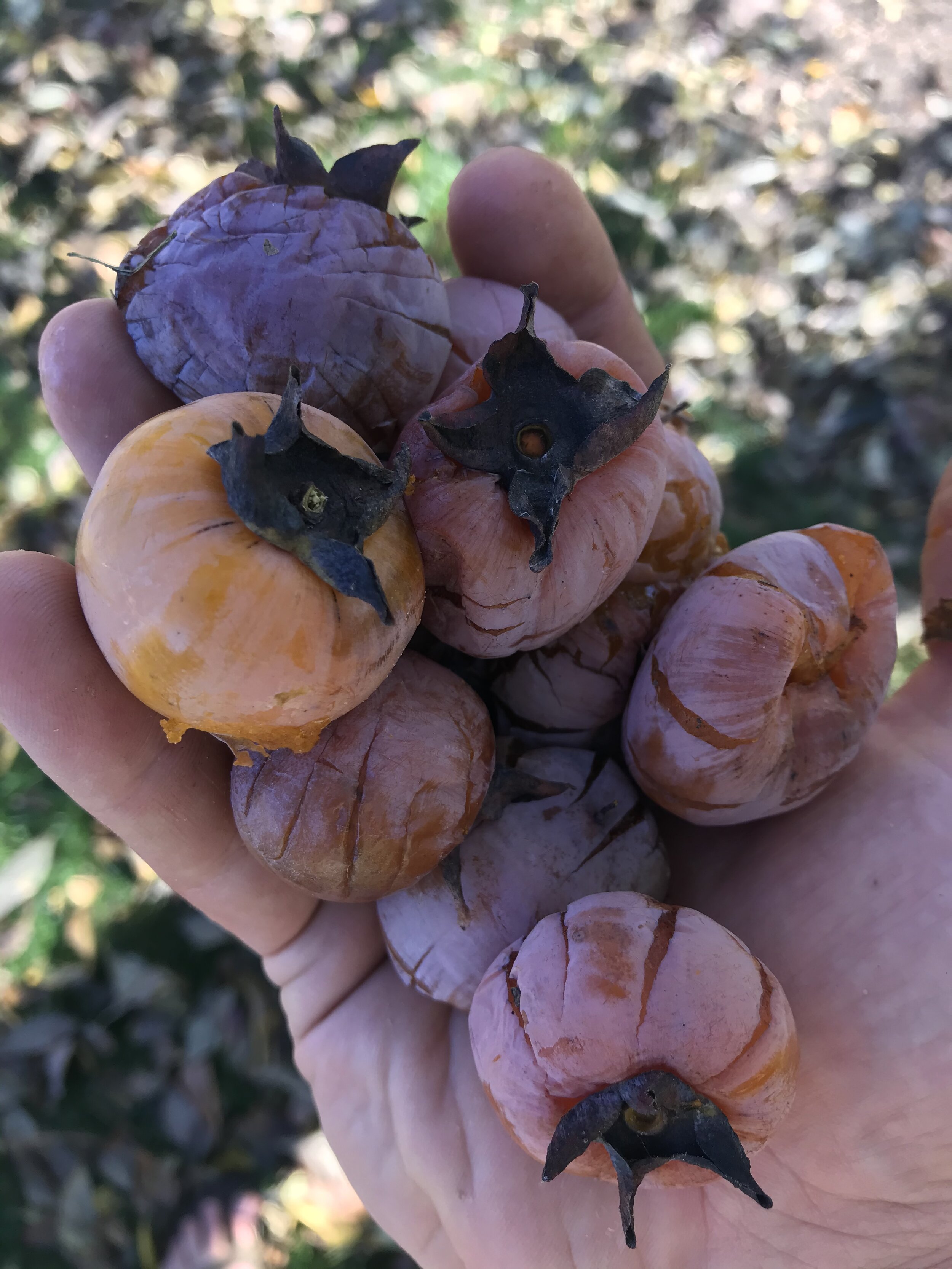Persimmon








Persimmon
Diospyros virginia
Plant for silvopasture possibilities, for riparian zone overstory, and for the most nutrient-dense native “fruit of the gods” and the “king of Southern foraged fruit”!
Hardy from Zones 4-9. 30-60 feet, 20-30 feet wide. Needs male and female to cross-pollinate.
Diospyros means “fruit of the gods,” which is right on the nose for Persimmon. But make sure the reddish-orange fruits are fully ripe before eating them or they’ll turn your mouth to chalk. Some claim hard frosts make them sweeter, but they’re ripe when soft and squishy and have an amazing unique flavor that’s wonderful fresh, dried, in puddings or breads or even beer and molasses from the fruit pulp. We like pressing them through a strainer to make delicious spread or fruit leather. Persimmons pack over 30% sugar and contain 19 out of 20 amino acids, nearly a perfect protein and making them the most nutrient dense fruit native to North America. If we don’t eat them all, then squirrel, fox, skunk, bear, coyote, raccoon, quail, wild turkey, cedar waxwing, and catbird will join the feast! Raccoons and foxes are primary planters, pooping out the seeds throughout the forest, which we unofficially endorse as an efficient propagation technique. Almost 50 species of caterpillars eat the leaves which, like the fruit, are high in Vitamin C and once were used to cure scurvy. The leaves make a lovely tea. Persimmons sleep a little later in the spring than most fruit trees, so their late flowers are an important nectar-source for bees.
Humans have been eating American ‘simmons down South for a long time. Wildlife guts sow many seeds, but the spread of Persimmon has also relied on the selection and distribution of Indigenous growers from the Colorado River and the Gulf of Mexico up through the Eastern Woodlands. The word persimmon comes from an Algonquin word meaning “dry fruit” and Cherokee medicine has used the fruit to treat diarrhea, sore throats, heartburn, and hemorrhoids. The pucker-inducing astringency makes a mouth rinse for sore throats and a decoction (a medicinal liquor made from concentrating) of boiled fruit has been used for bloody stools. Culinary historian Michael Twitty calls Persimmon the “king of Southern foraged fruit,” with a revered and joyful and pleasurable role in ancestral Black foodways. He’s written about enslaved trappers using Persimmon pulp and cornbread to clean out carrion-eating possum. Twitty also uses his grandmother’s recipe to brew Persimmon beer, a vitally nourishing drink for enslaved African workers. Carried by gourd or crock, fermented Persimmons offered a sanitary way to hydrate with sugar and vitamins. The drink tasted like home in a forced diaspora: Persimmon’s cousin jackalberry (Diospyros mespiliformis) grows widely in riparian buffers and savannas of Subsaharan Africa, often in mutual aid with termite mounds.
Native Persimmons start producing when only a few years old once the remarkably deep taproot is established, and they can spread through suckers as a survival tactic. A member of the Ebony family, the nearly-black heartwood is extremely strong, used for making golf club heads, and burns long and hot as firewood. The tree’s very recognizable by their gorgeous corky blocked bark, resembling the craggy scales of a crocodile. Persimmons like warm sunny spots with decent moisture but well-drained. Good riparian trees, though they’d prefer not to have constantly wet feet, and neither do we! Southern folklore says the seeds predict the harshness of winters. Split open a seed and look for three images: a spoon means you’ll shovel snow; a knife indicates cutting cold winds; but a fork cues you into a mild winter with enough eat. We haven’t tried yet, but we’ll let you know how it goes.
Right now, we don’t offer Asian Persimmon scion for grafting, but they’re still worth talking about here! Like their Native American cousin, Asian Persimmon ripens in Autumn but is a little crunchier than American. Asian Persimmon is native to China with over 2,000 cultivars now available. Marco Polo reported that Chinese traders exchanged Persimmon. Asian farmers introduced the tree to California in the 19th century, and they were the most widely grown fruit in East Asia until the 20th. Japan now ranks them as their 5th most important fruit where they’re popular as a medicinal tea to remove toxins, for cooling effects, and assistance with blood circulation and lowering blood pressure. A quarter of the fruit is sugar and peels have been powdered for sweetener. Those bitter tannins have been used to brew sake, but you can also lose the astringency by drying them into something like a date. Other incredible uses include as laxative, unripe fruit juice as an aid for hypertension, and, once again, unripe fruit ripened in containers with the leaves to make them sweet and relieve inflammation and fever. Oh, and the leaves are used for pickling radishes. This tree does just about everything.
We harvest our native seeds from tall healthy elegant trees with remarkably large sweet fruit that begin dropping in September and continue into Winter. Seedlings can be so-called male, female, or both, or can change, so plant a few just in case.